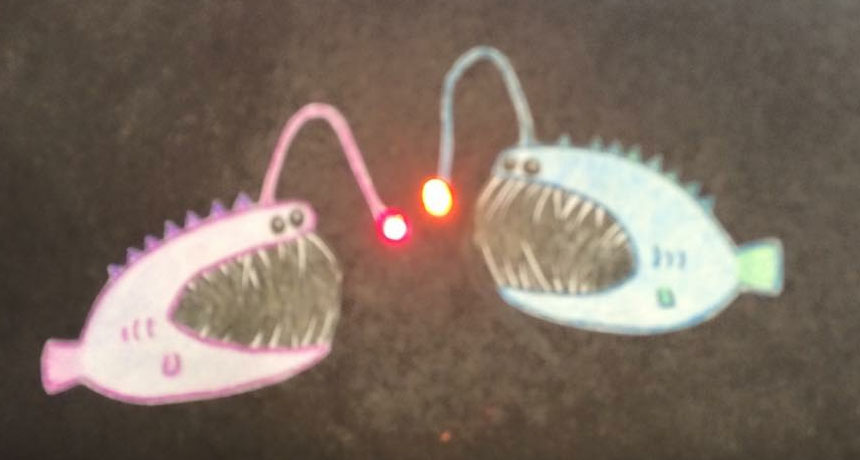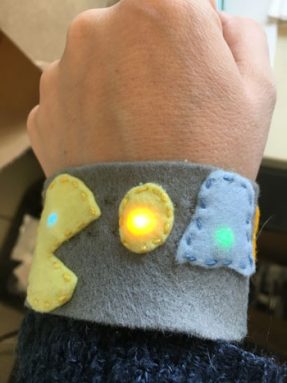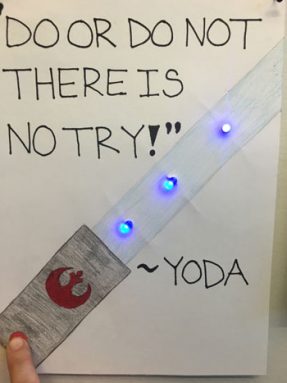Sewing circuits: A crafty way to get kids interested in STEM
Teachers can light up a classroom with conductive threads

One student used copper tape on the back of an art piece to send electric current to small lights. This made her anglerfish drawing glow.
C. Tofel-Grehl
NASHVILLE, Tenn. — With the use of thread that can conduct electricity, science education specialists have shown that combining electricity lessons with sewing arts and crafts can teach kids about currents — and dispel some stereotypes along the way.
Many science classrooms now use batteries, wires, alligator clips and lightbulbs to teach electrical circuitry. But while useful, these circuits have their limitations. There are usually only one or two ways to construct a circuit so the bulb will light up, notes Colby Tofel-Grehl. She is a science education researcher at Utah State University in Logan.
Fortunately, technology has gone far beyond wires and clips. Some threads now conduct currents. And some copper tapes can direct a current along a sheet of paper.
Allowing students to make their own “e-textiles” gives teachers an opportunity to combine learning about electricity with art, Tofel-Grehl says. Students can make paintings that light up and bracelets that glow. When combined with small microprocessors, kids can program their lights to work in patterns. Or they can combine their lights with sensors to make objects that respond to pressure, speeds and even temperature.
Science outreach professionals have been combining conductive thread and tape with art in science camps and other outside environments, notes Tofel-Grehl. But the techniques haven’t been used much within classrooms to teach the basics of circuits.

Both groups did equally well. But when asked about their science class and their interest in scientific careers, the kids who had created e-textiles were more likely to believe their teacher cared about their interest in science. What’s more, students who experimented with conductive thread and tape were more likely to take their projects home and more likely to report that their family would encourage them to pursue a career in science.
Electronics get crafty
The e-textile crafters seized the opportunity to get creative. Many made light-up paintings, from Harry Potter scenes to glowing anglerfish. Others made bracelets, and then developed their computer coding skills to program patterned light sequences into their fashion accessories. One student had noticed that he hunched over when he was on his smartphone. His solution: Build an accelerometer into his t-shirt, using e-textiles to hook it up to a light series. When his spine curved the wrong direction, the t-shirt warned him by lighting up.

With paper and copper tape in tow, Tofel-Grehl encouraged educators to try their hands at this during an April 1 session, here, at the National Science Teachers Association meeting. Attendees assembled their own circuits. And true to her expectations, no one succeeded the first time. But rather than get frustrated, the teachers reacted with glee, predicting how much their students would enjoy solving similar problems on their own. Tofel-Grehl also published a guide to “sewing science” in the November 2015 edition of The Science Teacher.
Combining electrical circuits with art is especially effective for girls, Tofel-Grehl says. “When we interviewed female students,” she recalls, they said: ‘I didn’t think I could do this. I would have told you I wasn’t into science. But this is really cool.’” As LEDs light up the world of fashion, e-textiles can help artsy or fashion-forward girls to realize that electronics aren’t just a boy thing.
The best part? Sewable electronics aren’t expensive. Large spools of conductive thread and copper tape are available all over the Internet on sites such as SparkFun and Amazon. Buying in bulk, Tofel-Grehl has gotten her own costs down to $1.50 per student.
Follow Eureka! Lab on Twitter
Power Words
(for more about Power Words, click here)
circuit A network of that transmits electrical signals. In the body, nerve cells create circuits that relay electrical signals to the brain. In electronics, wires typically route those signals to activate some mechanical, computational or other function.
current A fluid body — such as of water or air — that moves in a recognizable direction. (in electricity) The flow of electricity or the amount of electricity moving through some point over a particular period of time.
electric current A flow of charge, called electricity, usually from the movement of negatively charged particles, called electrons.
electricity A flow of charge, usually from the movement of negatively charged particles, called electrons.
electronics Devices that are powered by electricity but whose properties are controlled by the semiconductors or other circuitry that channel or gate the movement of electric charges.
e-textile A fabric that can have electrical components embedded in it. It can be something as simple as a series of lights that illuminate a bracelet or tent, or something as challenging as a jacket embedded with solar panels to charge up a smartphone.